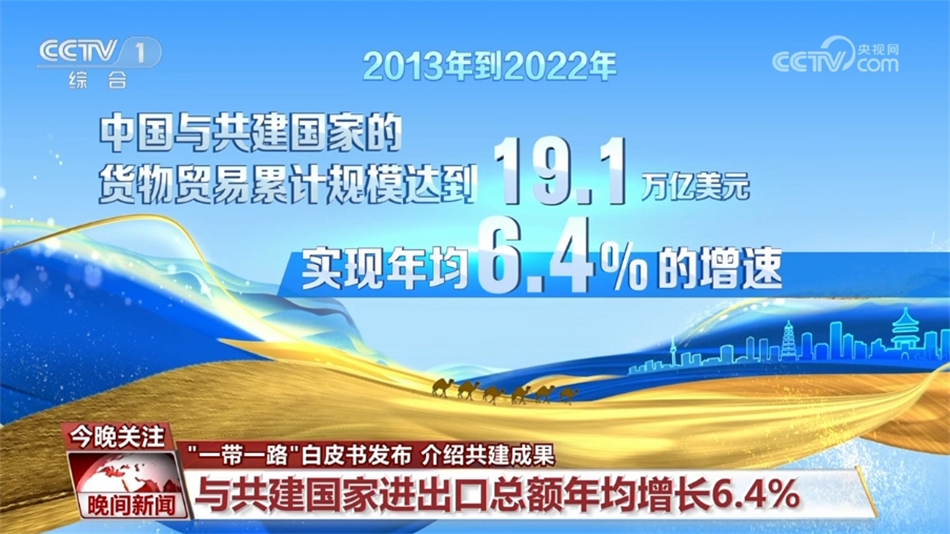Decisive Victory In The “14th Five-Year Plan” | Jointly Building The “Belt And Road” And Drawing A Picture Of Mutually Beneficial And Win-win Development
Decisive Victory In The “14th Five-Year Plan” | Jointly Building The “Belt And Road” And Drawing A Picture Of Mutually Beneficial And Win-win Development
Decisive victory in the "14th Five-Year Plan" | Jointly building the "Belt and Road" to draw a picture of mutually beneficial and win-win development, Central Europe, ASEAN, free trade area, Gwadar, 14th Five-Year Plan, One Belt and One Road
In the morning light at Xi'an International Port Station, the China-Europe freight train is loaded with Shaanxi apples and Sichuan electronic products, preparing to sail to Malaszewicz, Poland; under the scorching sun at Gwadar Port in Pakistan, local workers are loading China-aided construction machinery onto cargo ships and transporting them to northern Pakistan. In the mountains; on the platform in Vientiane, Laos, students boarded the China-Laos railway train with their schoolbags, smiling and greeting the Chinese conductors in Chinese - these three vivid scenes spanning the Eurasian continent are a vivid reflection of my country's "Belt and Road" construction moving from blueprint to reality.
Since the "14th Five-Year Plan", from the "steel camels" traveling across Asia and Europe to ocean-going ships connecting the world, from cross-border railways connecting mountains and rivers to cooperation parks nurturing vitality, the "Belt and Road" takes infrastructure as its backbone, trade cooperation as its veins, and people-to-people connections as its soul. It has woven a mutually beneficial and win-win picture of global development and has become a vivid practice of sharing opportunities between China and the world in the new era.
Facilities connect muscles and bones
In the early morning at the Putian Sales Department of Zhengzhou Railway Logistics Center, a China-Europe freight train loaded with machinery, equipment and auto parts slowly drove out and will arrive in Duisburg, Germany soon. At the same time, at the container terminal of Gwadar Port in Pakistan, quay cranes were accurately hoisting Chinese construction machinery onto cargo ships, preparing to send them to the Middle East. These scenes spanning mountains and seas are a vivid illustration of my country's deepening of infrastructure connectivity with countries co-building the "Belt and Road".
"Five years ago, we could send up to three China-Europe trains a day. Now there are more than a dozen outbound and return trains every day, and the screen in the dispatching room is always full of train plans ready to go." Li Zhenwu, a staff member of the Zhengzhou Railway Logistics Center, pointed to the big screen that updated in real time. In the past, train reloading relied entirely on manual labor. Now, by optimizing the process connection process such as cargo loading and shunting operations, the efficiency has more than tripled. As of June this year, the total number of China-Europe freight trains has exceeded 110,000, with a cargo value exceeding US$420 billion. The routes have covered 229 cities in 26 European countries and more than 100 cities in 11 Asian countries.
Maritime connectivity has also been fruitful. “I have worked here for 8 years and witnessed with my own eyes that a small wharf turned into a deep-water port capable of docking 100,000-ton ships!” said the operation and management staff of Gwadar Port with emotion. In order to further enhance the economic radiation of the port, Gwadar Port has built a free trade zone to attract companies to settle in through tax exemptions and logistics advantages. Currently, dozens of metallurgical and petrochemical companies have settled in the free trade zone, creating employment for a large number of surrounding residents.
"The joint construction of the 'Belt and Road' initiative has demonstrated the outstanding strength of China's engineering technology and management through the construction of transportation infrastructure, and has become an important driving force in promoting the economic development of relevant countries." The relevant person in charge of the Ministry of Transport said that the transportation infrastructure projects undertaken by Chinese enterprises overseas have created many local job opportunities, accelerated the pace of trade exchanges and industrial upgrading, and fully reflected the spirit of openness, inclusiveness, mutual benefit and win-win of the joint construction of the "Belt and Road" initiative.
Smooth trade and blood circulation
"In the past, imported cherries had to go through three or four middlemen, and it took more than a month to travel from Chilean orchards to Beijing supermarkets. Now through the 'South American maritime cold chain dedicated line domestic railway connection', the goods are shipped from Valparaiso Port in Chile, to Ningbo Port and then transferred to the cold chain train. The whole journey only takes 15 days, and the price is nearly 30% cheaper." Ms. Li, the person in charge of a fresh food supermarket in Beijing, is deeply touched by the changes in cross-border trade.
In addition to allowing "foreign goods" to enter China faster, the high-quality "Belt and Road" joint construction also allows "domestic goods" to go overseas more smoothly. Chen Gang, head of an automobile export company in Chongqing, said: "Our company mainly exports new energy vehicles to Southeast Asia. Five years ago, it took at least 20 days to arrive at the port by sea. Now it can be delivered in 7 days via the China-Laos Railway. The order volume has increased by 50% compared with before."
Data show that in 2024, the trade in goods between my country and the countries co-building the "Belt and Road" will reach 3.1 trillion US dollars, accounting for 50.7% of the overall trade. More high-quality products such as durian, dragon fruit, and coffee from the co-building countries will enter the Chinese market, and my country's mechanical equipment, electronic components and other related products will also help the industrial development of the co-building countries.
While the scale of import and export is growing, the facilitation reform of international trade has further accelerated commercial exchanges. "In the past, customs declaration required filling out more than a dozen forms and going to several departments. Now, the declaration can be completed in one go through the 'single window', and customs clearance can be completed in a few minutes at the fastest." said Zhao Na, a customs declarer at Chongqing Orchard Port. Since the "14th Five-Year Plan", our country has comprehensively strengthened the construction of smart customs, and the integration of national customs clearance has been fully realized. There are 964 items in 25 categories covered by the “one-stop service”, basically covering the entire chain of cross-border trade.
"Since the '14th Five-Year Plan', we have served high-quality joint construction of the 'Belt and Road' and greatly improved the level of trade security and facilitation. In 2024, my country's imports and exports with its joint construction partners will reach 22 trillion yuan, accounting for more than half, and imports and exports with emerging markets such as ASEAN, Latin America, Africa, and Central Asia will grow by more than 10% annually. my country has become the top three trading partners of 157 countries (regions) in the world." said Sun Meijun, director of the General Administration of Customs.
The foundation of people-to-people bonds is everlasting
"The China-Laos railway is not only a transportation line, but also a line of friendship!" Lao young man Atissa became a conductor after the opening of the China-Laos railway and is now proficient in serving passengers in Chinese. "Last week, a Chinese tourist taught me to use my mobile phone to check scenic spots, and I also recommended a Lao rice noodle shop to them!"
The relationship between countries lies in the mutual affinity between the people, and the mutual affinity between the peoples lies in the mutual understanding of the hearts. During the "14th Five-Year Plan" period, my country used institutional construction to promote "heart-to-heart connectivity" from single-point breakthroughs to systematic development, building an all-round exchange and cooperation pattern covering culture, people's livelihood, and talents, and injecting lasting vitality into jointly built relationships.
"I have been teaching Chinese in Kazakhstan for six years. In the past, only businessmen learned Chinese. Now students and doctors are signing up. They follow Chinese dramas and watch Chinese movies. The theater was packed when "The Wandering Earth" was released." According to Liu Min, a teacher at a Confucius Institute in Kazakhstan, cultural exchanges have become the best "glue" for the construction of the "Belt and Road". In addition, relying on platforms such as the Silk Road Tourism Cities Alliance, my country has held 10 consecutive World Cultural Heritage-themed tourism overseas promotion seasons, launched more than 6,000 digital resources, and carried out 18 offline activities in 15 countries and regions, with over 590 million overseas participants.
The people's livelihood cooperation in the high-quality joint construction of the "Belt and Road" has been accurately implemented with "small but beautiful" projects. Since the "14th Five-Year Plan", my country has carried out more than 1,700 foreign aid human resources development cooperation projects, promoted the "10-square-meter mushroom cultivation model" in Lesotho to help local farmers increase their income, exported hybrid rice technology to Burkina Faso to achieve "zero import" of rice, assisted the Tanzania broadband project to reduce local Internet tariffs by 75%, and anti-malarial aid with artemisinin as the core has benefited a total of 240 million people in sub-Saharan Africa...
Steel camel caravans cross the Eurasian continent, ocean-going freighters connect ports in all four seas, and cultural ties weave a map of friendship—these moving pictures across mountains and seas paint a win-win picture for the "One Belt, One Road" initiative during the "14th Five-Year Plan" period.
(Guangming Daily, Beijing, October 12)





